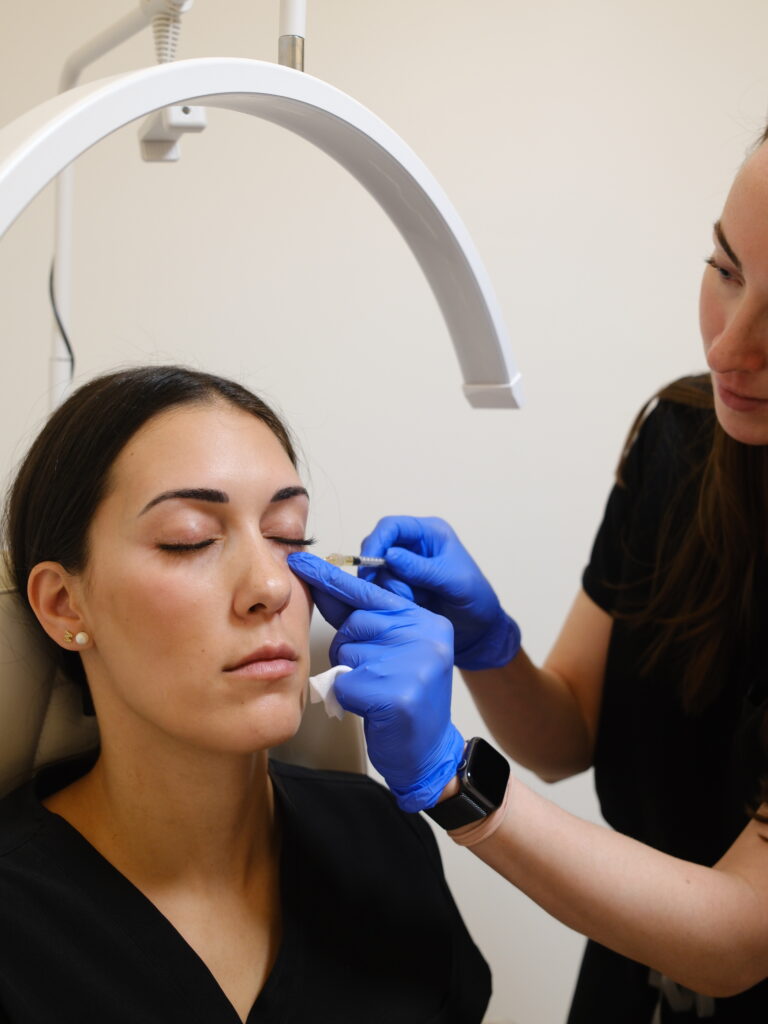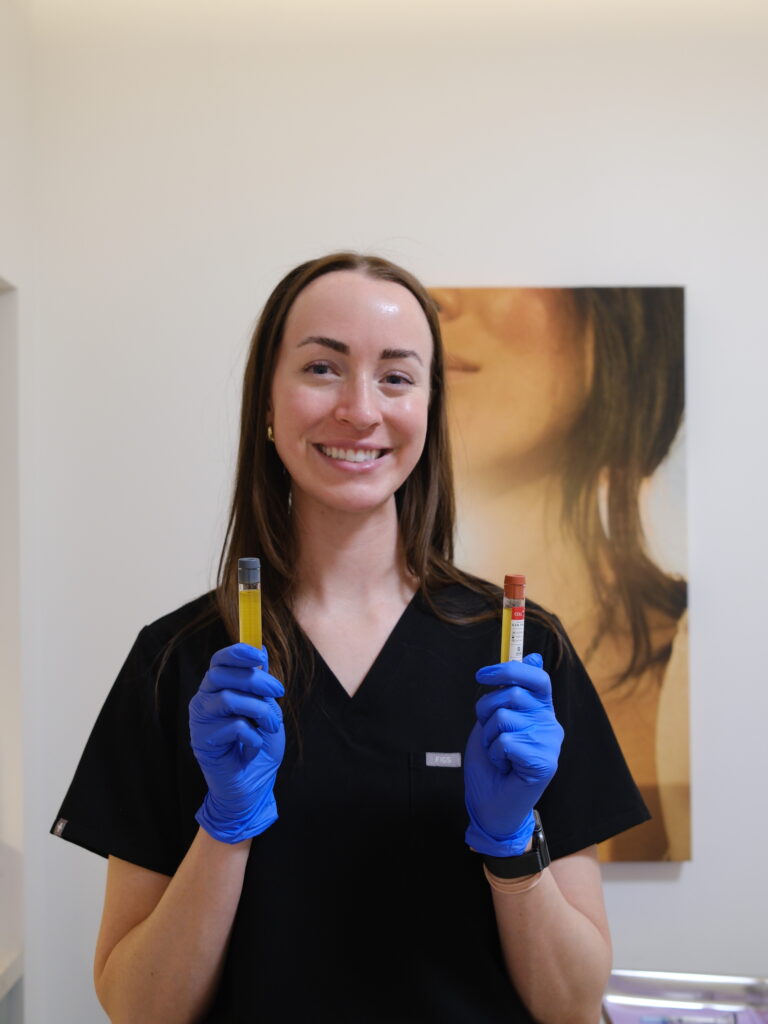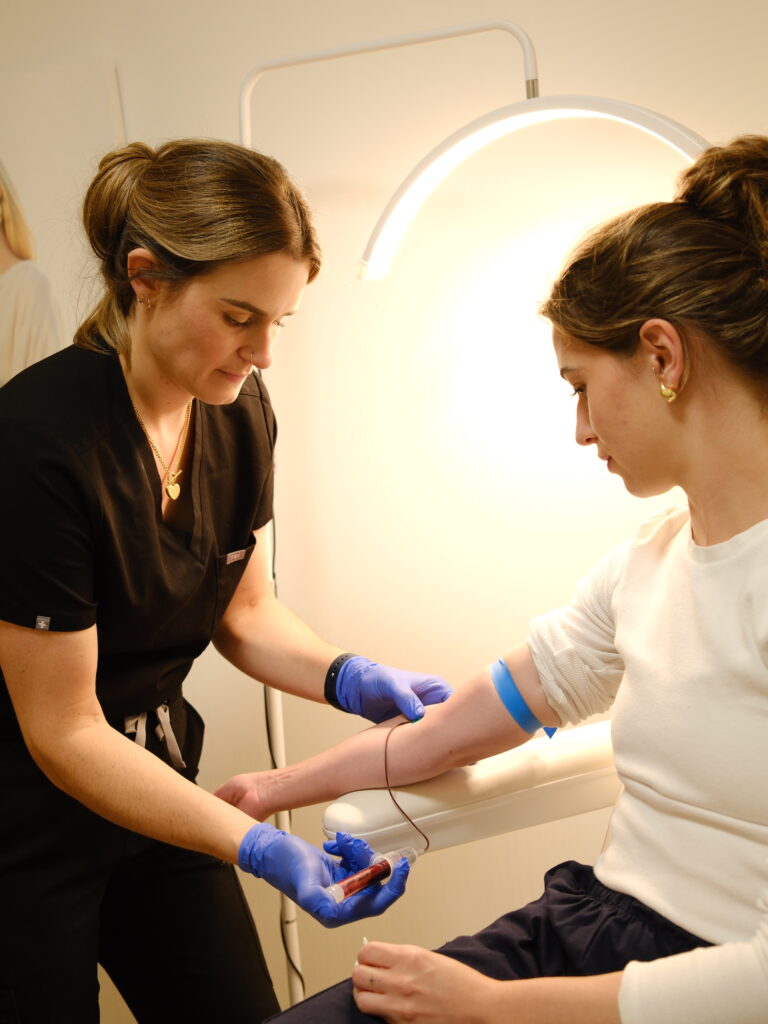Platelet Rich Fibrin Therapy

What is Platelet Rich Fibrin Therapy?
Platelet-Rich Fibrin (PRF) is a natural regenerative treatment created using a small sample of your own blood. Through a gentle spinning process, PRF preserves platelets, fibrin, white blood
cells, and growth factors that are slowly released over time to stimulate collagen production and improve skin quality. This gradual release supports longer-lasting, more natural rejuvenation with minimal inflammation.
PRF is commonly used to improve fine lines, skin texture, under-eye hollowness, and overall skin health, making it an excellent option for patients seeking subtle, regenerative results.
The Benefits of Platelet Rich Fibrin Therapy (PRF)
PRF for Under Eyes
- Improves dark circles and under-eye hollowing
- Stimulates collagen for smoother, firmer skin
- Enhances skin thickness and texture over time
- Uses your body’s own growth factors for natural results
- Minimal inflammation and lower risk of swelling compared to PRP
PRF for Hair Restoration
- Stimulates dormant hair follicles to encourage regrowth
- Improves hair density, thickness, and overall scalp health
- Prolongs the hair growth (anagen) phase
- Helps reduce hair shedding over time
- Natural treatment using your own platelets and growth factors
Microneedling with PRF (face)
- Enhances collagen and elastin production
- Improves skin tone, texture, and firmness
- Helps soften fine lines and acne scarring
- Accelerates healing and recovery post-microneedling
- Leaves skin visibly brighter, smoother, and more hydrated
PRF Pricing
-
PRF + Microneedling for Undereye Rejuvenation Combo Treatment:
$750/treatment (3 pack: $1800) - Optional add-on: Full face microneedling for $75
- Under Eye Rejuvenation: $500/treatment (3 pack: $1200)
- Hair Rejuvenation: $500/treatment (3 pack: $1200)
- Facial Microneedling with PRF: $500/treatment (3 pack: $1200)
-
Add-on microneedling to undereye: $250
(if already booked in for PRF under-eye. Cannot be added to hair) - Add-on PRF to microneedling: $200




What we offer at True
At True, we recommend an initial series of 3-6 PRF sessions, spaced about four weeks apart, for optimal results. Many clients begin to see improvement in hair density and texture within a few months, with continued benefits over time. PRP for hair restoration is safe, minimally invasive, and ideal for both men and women experiencing early to moderate hair thinning. Regular maintenance treatments may be recommended to sustain long-term results.
Frequently Asked Questions
How do I prepare for my treatment?
For ALL PRF Treatments
- Avoid blood thinners for 7 days prior to your appointment. This includes aspirin, NSAIDs (such as ibuprofen and Aleve), fish oil, vitamin E, ginkgo biloba, and St. John’s Wort. This helps minimize bruising and maximize platelet concentration.
- Avoid alcohol and caffeine for 24–48 hours prior, as both can thin the blood and increase the risk of bruising.
- Stay well-hydrated to support an easier blood draw and improve platelet quality.
- Avoid antihistamines for 7 days prior to treatment.
PRF for Under Eyes:
- Arrive with no makeup and a clean face.
- Avoid using active ingredients (such as retinol or acids) around the eyes for a few days before treatment.
PRF for Hair Loss:
- Arrive with a clean, freshly washed scalp—no products or styling agents on the day of treatment.
- Avoid hair dye for at least 72 hours prior to your appointment.
What’s the process and how long will it last?
Step 1: A Small Blood Draw
We start by taking a small amount of your blood—just like a routine lab test.
Step 2: Spinning the Blood
Your blood goes into a special machine that spins it to separate the rich plasma. This plasma is full of natural growth factors that help with healing, collagen production, and hair growth.
Step 3: Applying the PRP
Once we have your concentrated fibrin, we apply it in the area you’re treating:
- For Hair Loss: The PRF is gently injected into the scalp where hair is thinning. These growth factors help wake up inactive hair follicles and improve thickness over time.
- For Under Eyes: The PRF is carefully injected into the under-eye area to help with dark circles, fine lines, and crepey skin. It stimulates collagen and improves circulation for a refreshed, smoother look.
There’s little to no downtime, and since it’s your own plasma, the treatment is very natural and well-tolerated.
Will it hurt?
Most clients find PRF treatments very tolerable. You may feel a slight pinch or pressure during the injections, but we do everything we can to keep you comfortable.
How long is the recovery period?
- Mild swelling, redness, or itchiness at the injection site is normal and should subside within 24–36 hours.
- Bruising can occur, as with any injectable.
- Some puffiness or “overfilled” appearance is expected right after treatment—this is temporary and usually settles within 1–2 days.
- In rare cases, mild swelling (edema) may occur, especially in clients with allergies.
- The true results come gradually, as your body starts producing collagen and elastin in the treated area.
If symptoms last longer than expected, please reach out to us at
780-220-0344
When will I see results?
If you’re expecting instant or one-time results, PRF may not be the right fit. This treatment works by enhancing your body’s natural ability to produce collagen, which takes time. A series of sessions spaced about four weeks apart is typically needed, with visible improvements beginning around 4–6 weeks after each treatment. The most noticeable results develop gradually over a six-month period.
To maintain your outcome, a touch-up session is often recommended around the one-year mark, as the body continues to age and tissue naturally changes over time.
What are the after-care instructions?
Aftercare for All PRF Treatments
- Avoid touching, rubbing, or washing the treated area for 24 hours.
- No vigorous exercise, sweating, or exposure to heat (e.g., saunas, hot showers) for 24 hours.
- No alcohol for the first 24 hours
- Avoid NSAIDs like ibuprofen or Advil; use Tylenol if pain relief is needed.
- Do not take antihistamines for 72 hours post-treatment.
PRF for Under-Eye
- Mild swelling, redness, or bruising is normal and should subside within a few days.
- You may resume your regular skincare routine after 24 hours, but avoid harsh products or treatments for at least 72 hours.
PRF for Hair Restoration
- Let your hair air dry or blow dry gently—avoid washing or applying products for 72 hours.
- Avoid hair dye or chemical treatments for at least one week.
How often should I get this treatment?
For optimal results, a series of 3 to 6 sessions spaced approximately 4 weeks apart is generally recommended. Your provider may also suggest combining PRF with other modalities, such as microneedling, laser treatments, or medical-grade skincare, to enhance outcomes and achieve your desired aesthetic goals.
Are there any contraindications?
If you have any of the following conditions, PRF may not be suitable for you. Please review carefully, and if you have any of these conditions please call the clinic or book in for a consultation. If you arrive for treatment with any of the following conditions, the practitioner may refuse to treat you.
General Contraindications for PRF (All Treatment Areas)
- Active skin infection at the treatment site (bacterial, viral, or fungal)
- Blood disorders (e.g., platelet dysfunction syndromes, thrombocytopenia, bleeding disorders)
- Current anticoagulant (blood thinner) therapy that cannot be paused (e.g., Warfarin, Heparin)
- Active cancer or undergoing chemotherapy or radiation
- Pregnancy or breastfeeding
- Autoimmune disorders affecting skin healing (e.g., lupus, scleroderma)
- Uncontrolled diabetes
- Severe anemia
- History of keloid or hypertrophic scarring
- Known platelet dysfunction or very low platelet counts
- Recent use of corticosteroids or immunosuppressive therapy
- Smoking (may impair healing and affect results)
- Unrealistic expectations or psychological contraindications (e.g., body dysmorphia)
Specific Contraindications for PRF – Undereye Treatment
- Active skin conditions in the periorbital area (eczema, dermatitis, rosacea flare-ups)
- History of recurrent or active herpetic outbreaks in the treatment area (cold sores)
- Severe under-eye hollowing requiring surgical intervention rather than regenerative treatment
- Excessive skin laxity or bags under the eyes not suitable for PRP alone
- Recent use of dermal fillers in the area (typically should wait at least 4 weeks)
- Allergy to topical anesthetics, if applicable
Specific Contraindications for PRF – Hair Loss Treatment
- Active scalp infections or dermatitis
- Significant scarring alopecia or conditions like lichen planopilaris
- Completely bald areas with no viable hair follicles
- Recent hair transplant surgery (usually wait period required)
- Advanced, non-reversible stages of androgenetic alopecia
- Poor overall scalp health or hygiene
Contraindications for Blood Collection (Phlebotomy)
- Severe needle phobia that cannot be managed
- History of fainting or vasovagal syncope during blood draws
- Very low blood pressure or unstable cardiovascular status
- Severe anemia or hemoglobin deficiency
- Known bleeding disorders or inability to clot properly
- Active infection or illness at the time of blood draw
- Dehydration or poor venous access making blood draw unsafe



